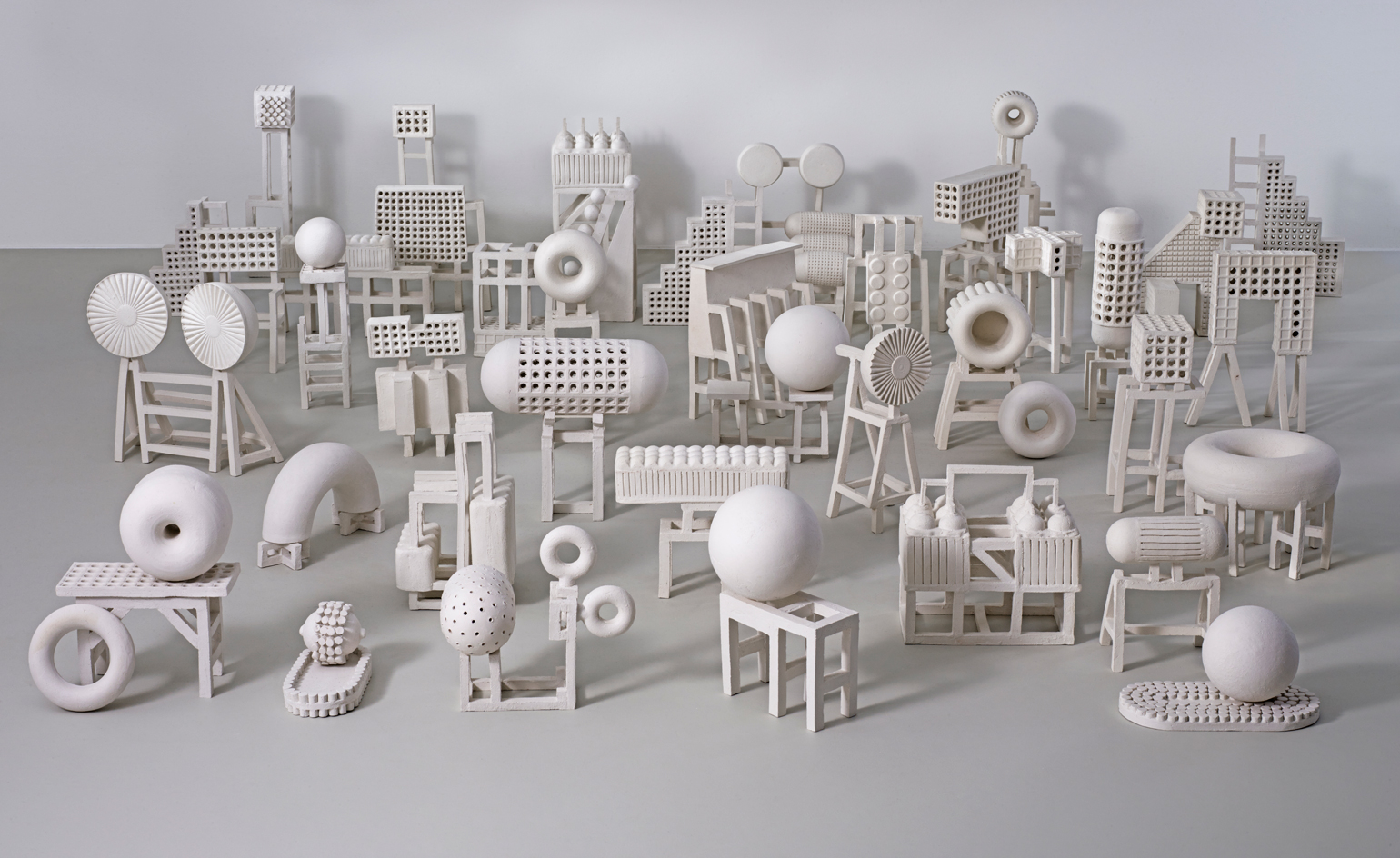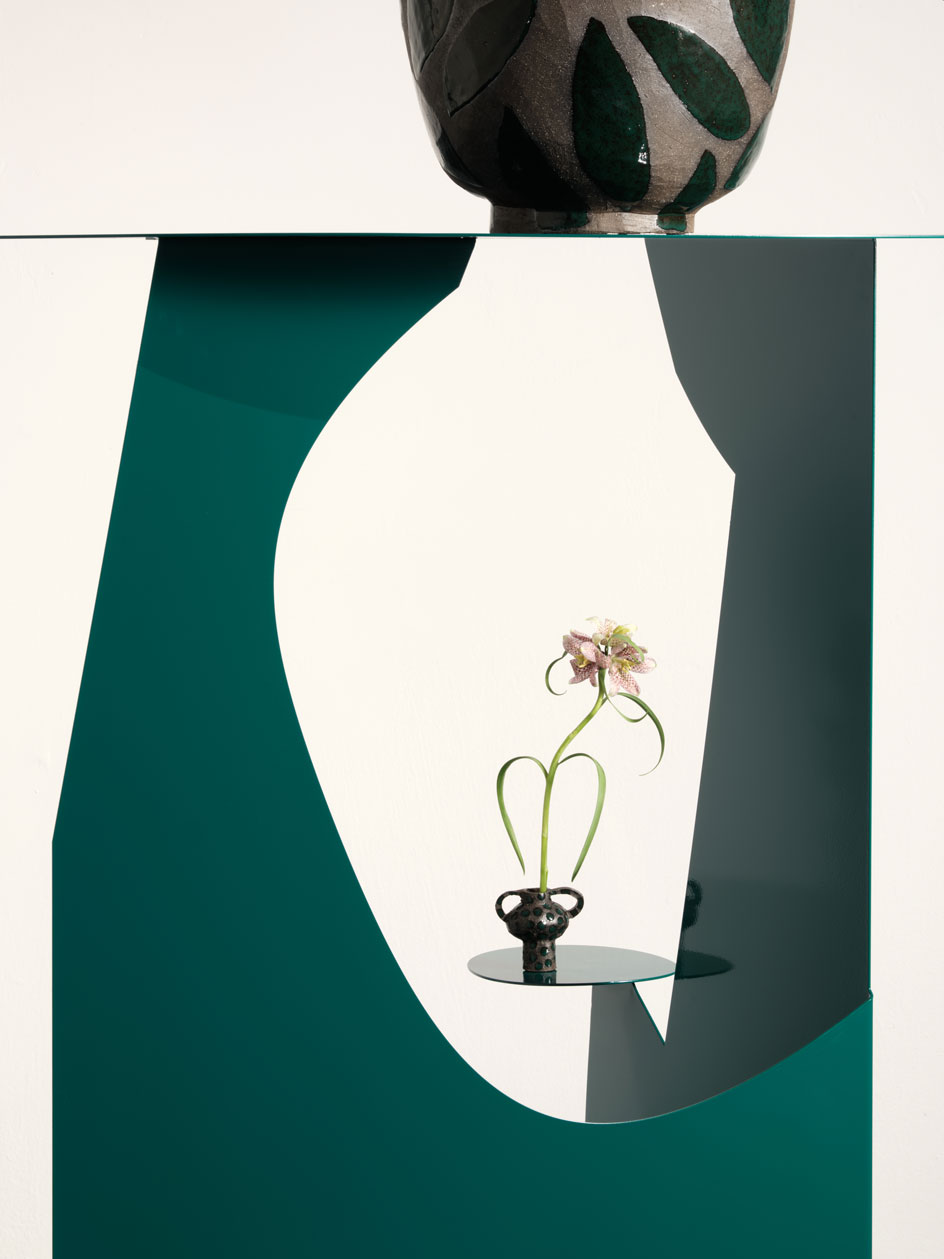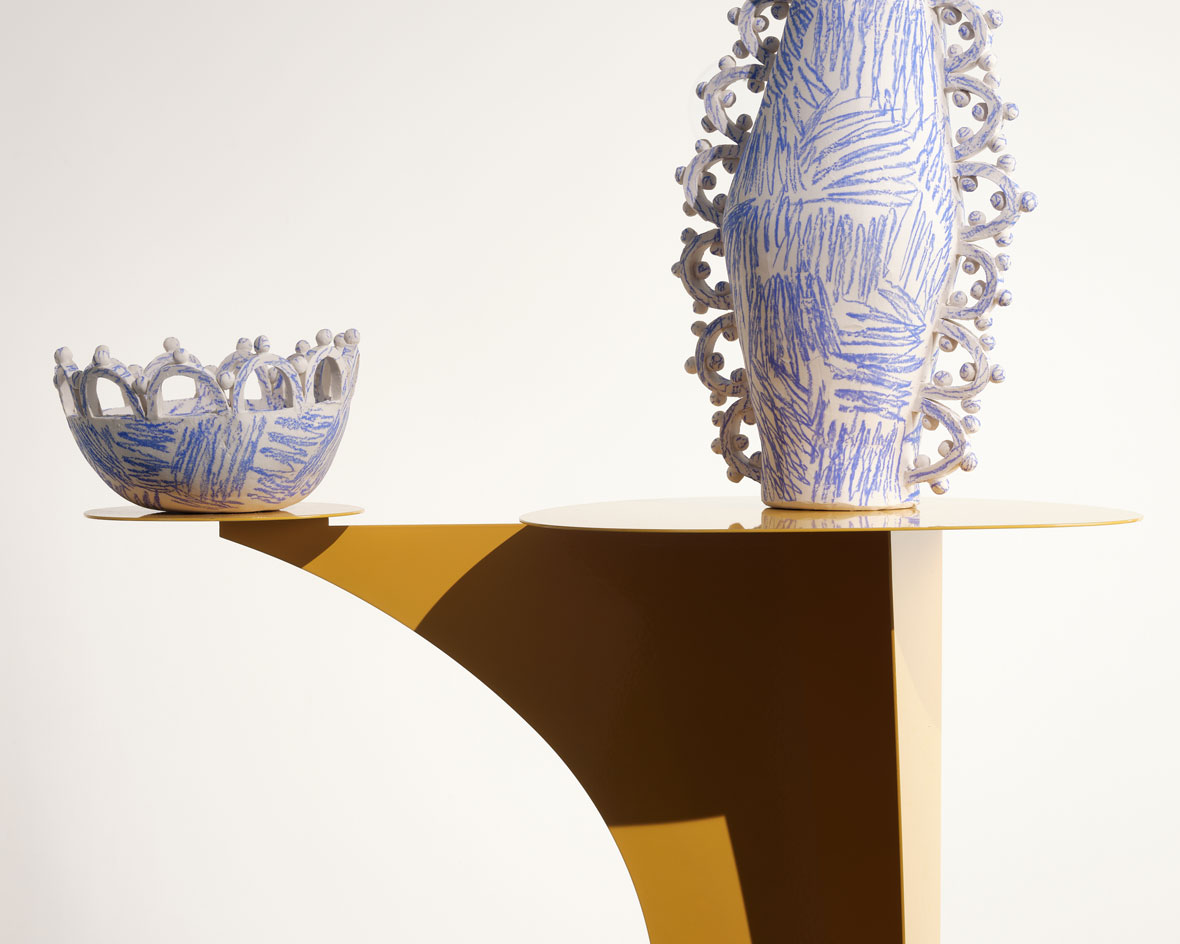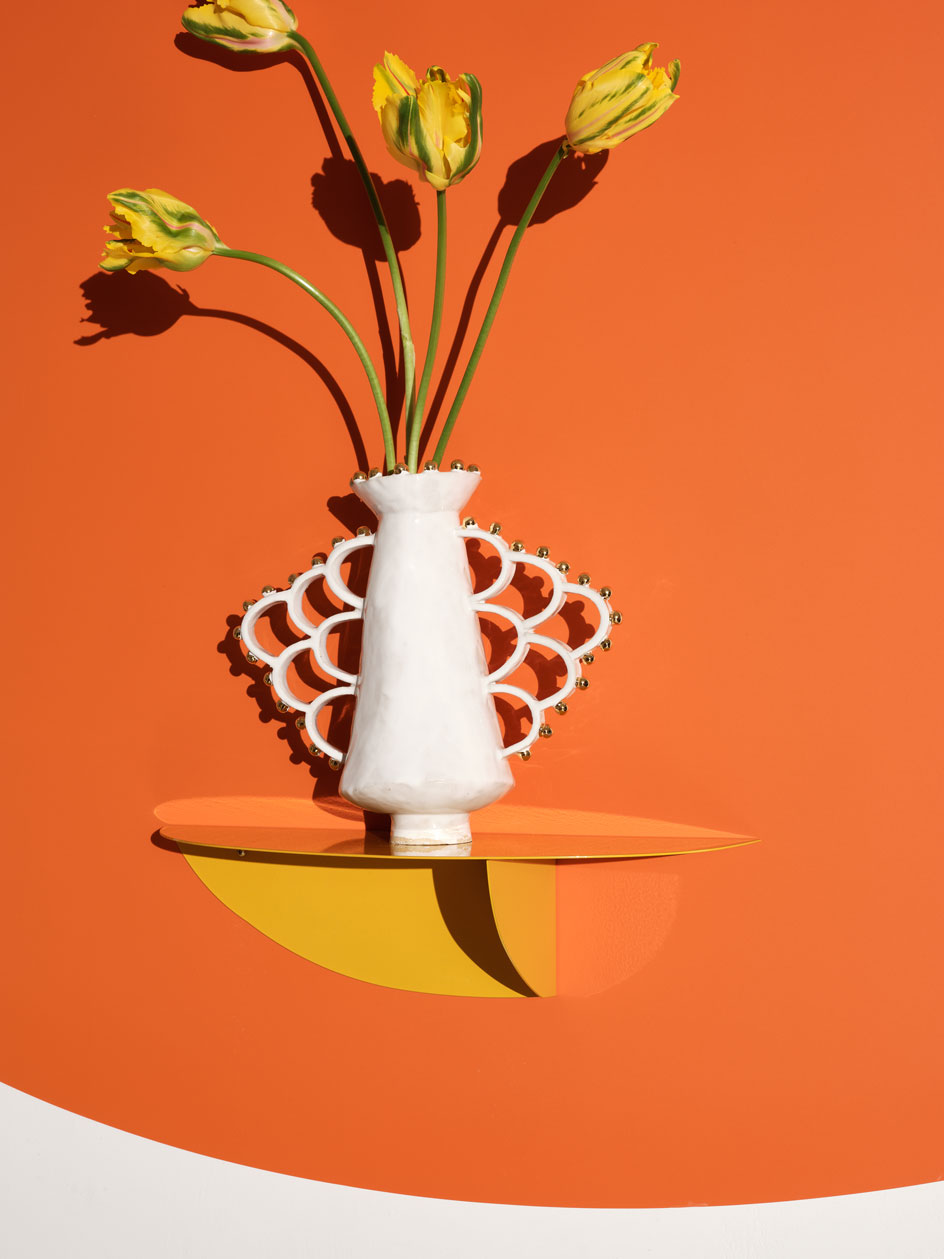Emily Mullin on creating ceramic sculptures with her husband
Teaming up with her husband for a new show ‘Get a Room’, ceramic artist and sculptor Emily Mullin celebrates collage, collaboration and the beauty of imperfection

While many couples would countersign to how the pandemic has tested the limits of their relationship, the Brooklyn-based ceramic artist and sculptor Emily Mullin instead chose to work with her husband, Tony Mullin, to produce her latest body of work, on view until 8 May at Jack Hanley Gallery in Manhattan. Entitled ‘Get a Room’, Mullin’s second solo exhibition at the space blurs the lines between sculpture, painting and collage with Mullin not only creating the vessels on display, but also the wall-bound reliefs and free-standing sculptural displays that frame each piece.
‘The show title is a cheeky nod to the romance of [the collaborative] process [with my husband]. We share a studio and plagiarise each other's palettes and forms constantly – is that collaborating? I don't know,’ Mullin jokes. ‘We spent so much time looking at images from places we have travelled, pieces from art collections we love, talking about architectural spaces- be that gallery spaces or domestic ones. These works let us imagine things we would want to live within a dream house we don't own. "Get a Room" also speaks to how one displays art, and how one lives with art.’


Portrait of Emily Mullin in the New York studio she shares with her husband, Tony. Below: Dripping, 2021. © Emily Mullin Courtesy the artist and Jack Hanley Gallery.
Inspired by the exhibition designs of the Italian architect Franco Albini and curator Caterina Marcenaro from the 1950s, whose emphasis on lightness and atmosphere redefined how to frame works in architectural spaces, Mullin’s intentionally two-dimensional displays – large scale CNC folded tables and plinths – are based on small, hand-cut paper maquettes which she and her husband composed together.
I love collage, Matisse and things that are less than perfect
‘The sculptural steel displays are fabricated using industrial processes which are generally so exacting. It's been fun to throw a spanner in the works and deliberately replicate rough, hand-cut, folded paper shapes using steel and a CNC press,’ she explains. ‘I build the vessels, similarly by taking flat slabs of clay and cutting out shapes and joining various pieces together. The push and pull on pictorial space in paintings when areas get flattened out is something I like to think about. I'm also interested in what happens when someone takes a photo of these dimensional works, and how everything transitions back to a 2D plane. I love collage, Matisse and things that are less than perfect.’
RELATED STORY



Installation view of ’Get a Room’ by at Jack Hanley Gallery in Manhattan. Below: Spring in Sardinia I (detail), 2021. © Emily and Tony Mullin. Courtesy the artist and Jack Hanley Gallery.
Retaining that paper cut-out quality on purpose, the displays add tongue-in-cheek humour to Mullin’s decorative, sculptural ceramic vessels, which are typically inspired by ‘costuming and embellishment – Grace Jones’ wardrobe, Sonia Delaunay’s stage costumes, Edo period Kimonos, Erte fashion illustrations, West Indian carnival costumes, pre-Columbian jewellery, Sardinian ceramics from the ‘50s... I could go on and on,’ she says. ‘I like to keep the surface of the vessels connected to motifs from abstract painting- whether that's with the washy wild effects of a raku-fired glaze, or through repeated mark-making and patternation.’
Emphasised by a colour palette that draws from Mullin’s childhood growing up in Los Angeles in the ‘90s, the show’s innate vibrancy is further enhanced by fresh floral arrangements that fill each vessel to quite literally breathe life into the display.
‘Theatricality and staging are important to me,’ she concludes. ’I like to think about the construction of images, framing devices, and the language of worship and desire. I've always thought of the works as altars that uplift the vessels and the floral elements that adorn them. There are all sorts of art historical and visual references in there, but fundamentally these pieces are a celebration of handmade objects and the natural world.’


Lace Revivalism (detail), 2021. © Emily Mullin. Courtesy the artist and Jack Hanley Gallery. Below: Installation view of ’Get a Room
INFORMATION
Emily Mullin: ’Get a Room’, until 8 May 2021, Jack Hanley Gallery. jackhanley.com
ADDRESS
Receive our daily digest of inspiration, escapism and design stories from around the world direct to your inbox.
327 Broome St
NY 10002
Pei-Ru Keh is a former US Editor at Wallpaper*. Born and raised in Singapore, she has been a New Yorker since 2013. Pei-Ru held various titles at Wallpaper* between 2007 and 2023. She reports on design, tech, art, architecture, fashion, beauty and lifestyle happenings in the United States, both in print and digitally. Pei-Ru took a key role in championing diversity and representation within Wallpaper's content pillars, actively seeking out stories that reflect a wide range of perspectives. She lives in Brooklyn with her husband and two children, and is currently learning how to drive.
-
 Terrified to get inked? This inviting Brooklyn tattoo parlour is for people who are 'a little bit nervous'
Terrified to get inked? This inviting Brooklyn tattoo parlour is for people who are 'a little bit nervous'With minty-green walls and an option to 'call mom', Tiny Zaps' Williamsburg location was designed to tame jitters
-
 Let’s hear it for the Chopard L.U.C Grand Strike chiming watch
Let’s hear it for the Chopard L.U.C Grand Strike chiming watchThe Swiss watchmaker’s most complicated timepiece to date features an innovative approach to producing a crystal-clear sound
-
 Form... and flavour? The best design-led restaurant debuts of 2025
Form... and flavour? The best design-led restaurant debuts of 2025A Wallpaper* edit of the restaurant interiors that shaped how we ate, gathered and lingered this year
-
 Out of office: The Wallpaper* editors’ picks of the week
Out of office: The Wallpaper* editors’ picks of the week'Tis the season for eating and drinking, and the Wallpaper* team embraced it wholeheartedly this week. Elsewhere: the best spot in Milan for clothing repairs and outdoor swimming in December
-
 Sculptor Woody De Othello paints a Miami museum red for a show that ‘almost hugs you’
Sculptor Woody De Othello paints a Miami museum red for a show that ‘almost hugs you’The Miami-born, California-based artist opens his first museum exhibition in his hometown as an experiential journey through life and lifeless objects
-
 Nadia Lee Cohen distils a distant American memory into an unflinching new photo book
Nadia Lee Cohen distils a distant American memory into an unflinching new photo book‘Holy Ohio’ documents the British photographer and filmmaker’s personal journey as she reconnects with distant family and her earliest American memories
-
 Out of office: The Wallpaper* editors’ picks of the week
Out of office: The Wallpaper* editors’ picks of the weekIt’s been a week of escapism: daydreams of Ghana sparked by lively local projects, glimpses of Tokyo on nostalgic film rolls, and a charming foray into the heart of Christmas as the festive season kicks off in earnest
-
 Ed Ruscha’s foray into chocolate is sweet, smart and very American
Ed Ruscha’s foray into chocolate is sweet, smart and very AmericanArt and chocolate combine deliciously in ‘Made in California’, a project from the artist with andSons Chocolatiers
-
 Inside the work of photographer Seydou Keïta, who captured portraits across West Africa
Inside the work of photographer Seydou Keïta, who captured portraits across West Africa‘Seydou Keïta: A Tactile Lens’, an exhibition at the Brooklyn Museum, New York, celebrates the 20th-century photographer
-
 Out of office: The Wallpaper* editors’ picks of the week
Out of office: The Wallpaper* editors’ picks of the weekFrom sumo wrestling to Singaporean fare, medieval manuscripts to magnetic exhibitions, the Wallpaper* team have traversed the length and breadth of culture in the capital this week
-
 María Berrío creates fantastical worlds from Japanese-paper collages in New York
María Berrío creates fantastical worlds from Japanese-paper collages in New YorkNew York-based Colombian artist María Berrío explores a love of folklore and myth in delicate and colourful works on paper